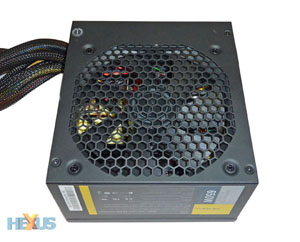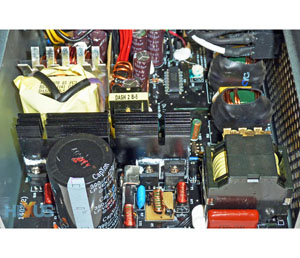Building on established foundations
Why have gold when you can have platinum?
We've recently covered high-wattage power-supply units (PSUs) from Antec and XFX. High on power invariably leads to high prices, and readers can expect to pay the wrong side of £200 for a top-spec. 1,250W supply.
Simple economics informs us that PSU manufacturers will make the most money from mainstream supplies. Corner this market and there's plentiful coin to be had, and we believe that the 400W-750W range in each company's line-up needs to be strong, taking liberally from the technology waterfall effect arising from designing cutting-edge (and expensive) 1kW-plus PSUs.
Antec is giving its mainstream EarthWatts range a makeover with the release of three 80 PLUS Platinum-certified supplies. The 450W, 550W, and 650W PSUs need to have 94 per cent efficiency at 50 per cent load from a 230V source, while still maintaining 90pc and 91pc for 20pc and 100pc loads, respectively. It's a tough ask, no doubt, and, patently ignoring the server-orientated Titanium classification, represents the zenith of what's achievable for mass-market PSUs.
While we continue to bemoan the myopic focus on efficiency above all else, super-efficient supplies should produce very little heat and therefore be easy to cool. Let's see how Antec goes about it with our look at a (slightly) pre-production 650W unit.
Measuring 150mm (w) x 140mm (d) x 86mm (h) and using a honeycombed pattern on the 0.8mm-thick SECC housing, Antec is looking to provide value for a Platinum-rated supply, which sounds oxymoronic at first perusal. This unit will likely retail for £100, putting it at the very high end of the mid-wattage market - a 650W EarthWatts Bronze can be purchased for just over half this outlay, we note.
Attack of the clones
The unit is well-built and, if we had to lay our money on it, reckon that FSP is the original manufacturer, basing this model on its Aurum line, with Antec providing a few tweaks here or there. Most mid-range Platinum PSUs - and there aren't very many about - are tweaked versions of Gold models. Real innovation tends to happen at the top end of the market.
The 120mm double-ball-bearing fan literally sits on top of the innards and is fixed in position through four screws on the top. Cooling becomes less of a concern as efficiency rises; the PSU doesn't expend too many watts to heat, and this is why the internal heatsinks are small and the specifics of the fan relatively unimportant.
Peering inside confirms the supply's provenance to be FSP; we've seen this design adopted by other companies, too. Look top-right of the left-hand picture and you'll notice a familiar transient filtering setup - well, familiar if you're a PSU geek - of three Y caps, two X caps, and three ferrite coils. There's no metal-oxide varistor present here, however, but there's really no need when using a full-range PSU.
Coming further down the PCB, the power-factor-controller (PFC) is governed by two Infineon MOSFETs (IPB60R125P), which in turn are filtered by the huge capacitor you see in the foreground. It's interesting to see that Antec has opted for a CapXon, rated at 85°C, whereas FSP's Aurum runs with the usual Rubycon certified at 105°C: higher temperature tolerance is better.
The numbers
In fact, let's cut to the chase; the Antec EarthWatts 650W Platinum is a tweaked version of the FSP Aurum, and that's no bad thing. Here's how it's rated:
| Amps/watts and voltage | 3.3V | 5V | 12V1 | 12V2 | 12V3 | 12V4 | -12V | -5VSB |
|---|---|---|---|---|---|---|---|---|
| Rail amps | 20A | 18A | 30A | 30A | 30A | 30A | 0.3A | 3A |
| Maximum rating | 105W | 576W |
3.6W | 15W | ||||
| Maximum rating continuous | 650W |
|||||||
Split into four 12V rails that can push out a combined 48A and armed with the usual range of PSU-protecting mechanisms, everything seems to be in order here.
Both 6+2-pin PCIe graphics plugs run off a single 12V rail, meaning you don't want to overburden it with heavy-duty graphics, though with OCP and OVP able to push the power-draw higher for short-term loads, rising up to 45A (540W). Though Antec does not specify exactly which cards can't be used with this supply, we'd look at using no more than two (non-overclocked) Radeon HD 6950s or GeForce GTX 560 Tis for long-term running.
Pragmatically, it provides more than enough juice for a high-end build, encompassing an Intel Core i5/i7 (non-extreme) chip, top-line graphics card and a multitude of drives. Cabling, and just how it's wired, is also of import, so let's skip to that.
| Cables | Cables, type, length, plugs on cable | |||||||
|---|---|---|---|---|---|---|---|---|
| Main | x1 20+4-pin (52cm) | |||||||
| ATX/EPS | x1 4+4 (60cm) | |||||||
| PCIe | x2 6+2 (52cm and 67cm) x2 | |||||||
| SATA | x6 (52cm-82cm) x3, x3 | |||||||
| Molex | x4 (52-97cm) x3, x1 | |||||||
| Floppy | x1 (with Molex) | |||||||
All SATA/Molex cables are connected up to 12V4, while the CPU 8-pin and 24-pin each get 12V2 and 12V3. Lengths are satisfactory and the types of connectors are sensibly grouped together.
Money matters - putting efficiency to the test
You're effectively paying a solid price premium for high efficiency. Antec makes a fair deal out of commenting just how much electricity, and therefore money, can be saved when running a Platinum PSU, so let's crunch the numbers in a back-of-the-envelope kind of way.
Let's assume the reference 650W PSU is a 80 PLUS Bronze retailing at £60, or just over half this Platinum's price. Now let's assume that there are three types of users: low-loaders (mainly desktop work), mid-loaders (games and 2D work), and heavy-loaders (distributed computing and gaming), and they, on average, pull 20 per cent, 50 per cent, and 100 per cent, respectively, of the available power.
Now that we're happy with assuming quite a lot, let's also say the PCs are used for six, 10, and 18 hours a day, 365 days of the year, for the three types of users. And let's say that electricity works out, on average, at 15p per kilowatt hour. Phew. Here are three tables to sum it up:
| Low load 20pc | Percentage load | Wattage required from PSU | Minimum efficiency at 20pc | Wattage from mains | Total watts in day | Cost per day | Cost per year | Saving |
|---|---|---|---|---|---|---|---|---|
| 80 PLUS Bronze | 20pc | 130W | 81pc | 160.5W | 963W | £0.144 | £52.72 | 0 |
| Antec Platinum | 20pc | 130W | 90pc | 144.5W | 867W | £0.130 | £47.47 | £5.25 |
| Mid load 50pc | Percentage load | Wattage required from PSU | Minimum efficiency at 50pc | Wattage from mains | Total watts in day | Cost per day | Cost per year | Saving |
|---|---|---|---|---|---|---|---|---|
| 80 PLUS Bronze | 50pc | 325W | 85pc | 382.3W | 3,823W | £0.573 | £209.31 | 0 |
| Antec Platinum | 50pc | 325W | 94pc | 345.7W | 3,457W | £0.518 | £189.27 | £20.04 |
| Max load 100pc | Percentage load | Wattage required from PSU | Minimum efficiency at 100pc | Wattage from mains | Total watts in day | Cost per day | Cost per year | Saving |
|---|---|---|---|---|---|---|---|---|
| 80 PLUS Bronze | 100pc | 650W | 81pc | 802.5W | 14,445W | £2.167 | £790.86 | 0 |
| Antec Platinum | 100pc | 650W | 91pc | 714.3W | 12,857W | £1.929 | £703.92 | £86.94 |
These numbers give you an idea of how efficiency translates to real-world finance. Most readers' usage will fit between these three models, and it's clear and obvious that savings increase as consumption grows. In fact, going against the grain in commentary earlier in this review, Platinum-rated supplies can make sense for mainstream supplies.













